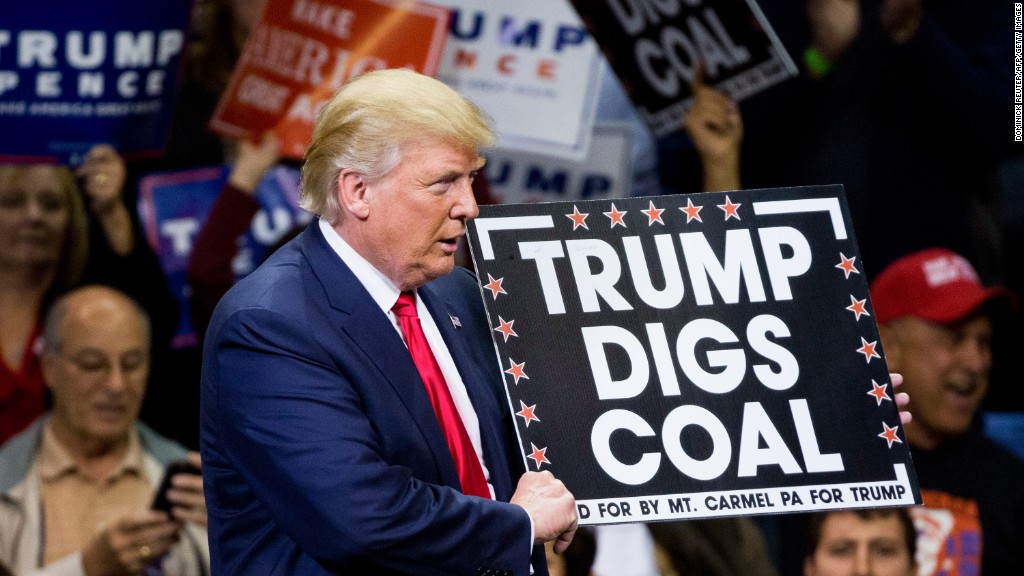
President Trump has imposed tariffs on imported solar panels, ripped up environmental rules, pushed through oil pipelines and attempted a daring rescue of the coal industry.
Not to mention his vow to pull the United States out of the Paris climate accord.
Yet the renewable energy movement is still standing -- and poised for continued growth thanks to powerful momentum pushing America toward a cleaner energy future.
Renewable energy is thriving because of plunging solar and wind costs as well as strong support from the public, governors and Corporate America.
"Renewables have boomed because costs keep coming down and businesses and consumers are pushing for green power," said Andy Smith, an analyst at Edward Jones. "They don't want dirty coal emissions."
Power companies are already shutting coal-fired plants in favor of cleaner natural gas and renewables.
"Nothing that Trump has said or done yet is going to change that. The president only has so much power," Smith said.
Trump dealt the solar industry a blow this week by putting a 30% tariff on foreign solar panels. The solar industry warns that the move will cost 23,000 American jobs. Goldman Sachs estimates the tariffs will raise the cost of solar 3% for utilities and 7% for customers.
Related: How Trump's solar tariffs could threaten jobs
'More smoke than fire'
Yet the solar industry isn't freaking out. It views the tariffs as a temporary setback, not a knockout punch.
"Solar's long-term prospects are much more powerful than one tariff decision," Ed Fenster, executive chairman of solar-energy leader Sunrun (RUN), told CNNMoney. "Solar's future is secure even in the face of temporary poor federal policy."
Many in the solar world were bracing for more punishing tariffs from Trump.
"It's a lot more smoke than fire," said Bryan Birsic, CEO of Wunder Capital, which develops and manages solar investments. Birsic is "excited" about where the tariffs landed compared with what he expected.
Utility company Duke Energy (DUKH) acknowledged that the solar panel tariffs will "hurt" its plan to nearly quadruple solar power capacity over the next five years.
However, Duke said it will "continue to invest in this resource" because "our customers expect solar to be a key component of an affordable and clean energy generation mix."
Renewables are getting cheaper
Simple economics has helped renewables take off. New technology, soaring investment dollars and government support have drastically lowered the cost of wind and solar, allowing them to be competitive with fossil fuels in some places.
The cost of solar electricity plummeted two-thirds between 2010 and 2017, according to the National Renewable Energy Laboratory.
The Energy Information Administration estimates that renewable energy now makes up about 17% of U.S. electricity generation, up from just 8% in 2001.
Coal's share of the electric grid plummeted to 30% last year, from more than half in 2001, according to the EIA. Much of that decline was driven by the abundance of cheap natural gas thanks to the shale revolution.
The EIA expects renewables and natural gas to steal more market share in the next two years, while coal is projected to decline further.
"The reality is that renewables are increasingly cost-effective," said PJ Deschenes, a partner at Greentech Capital Advisors, a clean energy investment bank.
Solar costs are expected to keep going down in the long run. The cost of solar electricity is poised to crater by 66% by 2040, according to a forecast last year by the research firm Bloomberg New Energy Finance. The report predicted U.S. power generation from renewable energy will skyrocket 169% in that time.
Bank of America Merrill Lynch expects clean energy will account for up to 80% of all the new power in the world through 2040.
Related: Mine closing wipes out many of Trump's coal job gains
Trump's attempted coal rescue
The renewable energy industry lost a big source of support when former President Barack Obama was replaced by Trump.
One of Trump's first moves was to advance the stalled Keystone and Dakota Access oil pipelines.
Trump has repeatedly promised to resuscitate the coal industry. Last year, he moved to roll back Obama-era environmental rules, and Energy Secretary Rick Perry proposed a controversial plan to prop up slumping coal companies.
But the renewable industry dodged a bullet in January when the Federal Energy Regulatory Commission unanimously dismissed Perry's call to subsidize coal and nuclear power plants.
"The administration has shown blatant favoritism to traditional energy sources such as fossil fuels," said Tao Kong, chief operating officer at Alcen Renewable, which develops wind and solar projects for utilities.
Grassroots green support
The Trump administration has so far mostly avoided outright targeting renewables, which enjoy strong public support.
Early versions of the federal tax overhaul would have eliminated renewable energy tax credits. Ultimately, Trump's signature legislative achievement largely preserved vital credits for wind and solar.
"We haven't seen very many direct actions hitting renewables as much as support for coal, fossil fuels and nuclear," said Roman Kramarchuk, head of energy policy at S&P Global Platts.
While Washington may be tilting toward fossil fuels these days, support in the states is on the rise -- and that's where much energy policy is conducted.
Twenty-nine states have adopted standards that require utilities to use a certain amount of renewable energy, according to the National Conference of State Legislatures.
"We've seen very substantial bipartisan support for renewable energy," said Sunrun's Fenster. "There is a lot states can do here."
--Correction: An earlier version of this story gave an incorrect title for Tao Kong.


